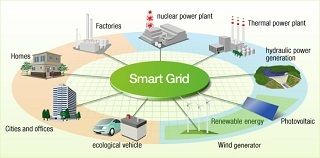From 2Green Energy Intern Fabio Porcu: The Future of Power Generation, Transmission, Distribution, and Consumption–“The Smart Grid”

The current system for energy generation is based on energy produced in large power plants: about 30% from coal; most of the other 70% is a combination of natural gas, and nuclear. Around those big power plants are developed distribution networks. Such energy sources are nonrenewable and, especially coal, is highly polluting, so it becomes necessary to reduce the use of this source and to replace it with renewable energy.
The deactivation, in whole or in part, of traditional energy plants means replacing them with other energy sources, in particular, renewable energy. Meeting this great challenge is made more feasible with smart grid, which helps meet the average daily demand of energy with renewables. The main characteristics of the smart grid are the following:
Intelligent networks: This refers to the fact that with smart grid the communication and the transfer of energy are no longer undirectional, but instead are bidirectional, necessitating an exchange of real-time information between the utility which provides energy and the end consumer. To achieve this type of network, it becomes essential to use devices such as smart metering communications, i.e., devices for automated real-time management of energy demand as compared to the available production. The user is no more just a remote load receiving energy.
- Open networks: This means that the network accepts energy from any source by integrating all types of generation. In this case, the network must be able to manage relevant energy flows that arrive from thermal power stations as well as flows from much more modest residential solar systems.
- Networks capable of self-diagnosis: Through devices with computing capabilities, one can diagnose in real-time possible malfunctions of the network and prevent holes or overload voltage. When these problems are experienced, procedures for the solution of the problem is initiated.
- Strong networks: Ideally, the network should be able to deal with attacks by hackers, natural disasters or accidents. This reduces the number of events that may interrupt the flow of energy and thus create considerable discomfort to a vast number of users as well as the utility.
- Networks with Internet Technologies: Often smart grid devices use Internet protocols for data exchange and security.
Given the major features that are required of smart grid, we see now the architecture that the network should have in order to meet all its many challenges. The development of this type of technology requires considerable efforts at various levels:
- Technological: It is necessary to develop patented technologies, both by individuals investing in energy companies and the state, with its investments in research and development.
- Legislative: The states must produce regulations governing this new type of technology that will change the energy market.
- Technical Guidelines: Standards must be developed that define certain aspects of the smart grid, and ensure that infrastructure and formats for the data traveling on the network are fully compatible among all states.
All this is necessary in order to obtain significant energy savings by lowering the energy demand as much as possible during peak hours, and then to minimize the use of traditional, highly polluting centralized power plants. New technology brings not only environmental benefits, and should be respected not only for compliance with the new guidelines, but also for significant economic benefits. The direct economic benefits are principally four:
- Increasing electric distribution efficiency
- Improving revenue capture through improved Smart Meter accuracy
- Reducing operating costs from capabilities such as remote meter reading and remote service disconnect/reconnect
- Facilitating changes in customer behavior, either by shifting usage away from high-demand periods or by reducing usage. These capabilities include offering customers more choices including time-varying rates, prepayment programs, and customer energy management systems.
Smart Grid also brings indirect benefits for the community, including:
- Economic productivity increase associated with improved grid reliability
- Capabilities such as fault location help repair crews find faults faster
- Fault isolation limits the number of customers impacted by any particular service outage
